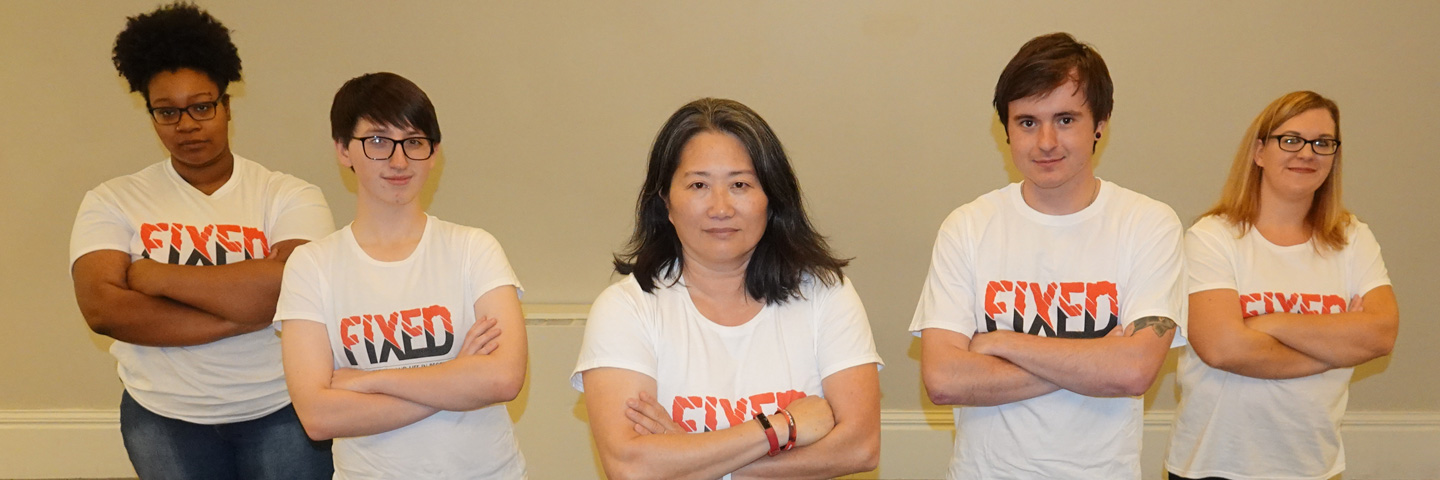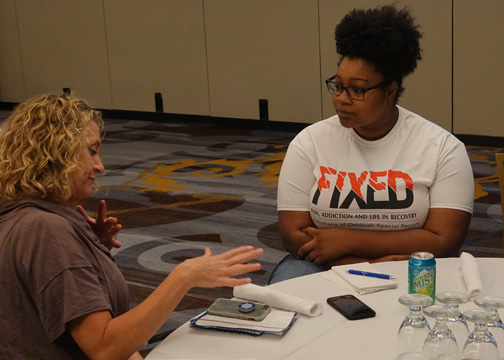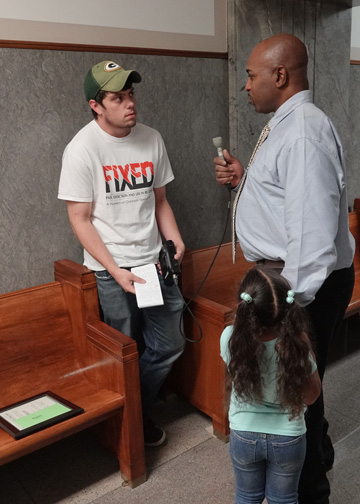
From the Editor
Grace Lim
My students think the Fixed: Pain, Addiction and Life in Recovery project started at the beginning of fall 2019, but it actually started two years earlier at a lunch meeting with Sue Panek, past president of United Way of Oshkosh, and current member of the Breakwater, formerly the Winnebago County Drug and Alcohol Coalition. Long story short, Sue suggested tackling heroin as a Humans of Oshkosh project.
Heroin? Here? In Oshkosh, in Winnebago County? I admit, I pushed that terrible dark idea away. At that time I was also teaching a general education course. I rationalized that addiction was not the right topic for that group of students, mostly business majors, who thought the class was a cakewalk based on its title, “Telling Stories for Fun, Profit and World Peace.”

From l-r: FIXED student editor Bethanie Gengler, Wisconsin State Rep. Gordon Hintz, UWO instructor and FIXED editor Grace Lim and Wisconsin Gov. Tony Evers
For some of us, myself included, the idea of addiction to heroin or meth or alcohol is a hazy picture of someone under a bridge drinking out of a paper bag or shooting up.
Celebrities* who battle substance abuse, such as Robert Downey, Jr. and Ben Affleck (Ironman and Batman!), often have their addiction experiences dismissed as cases of over-indulgence. Our own Packer Hall of Famer Brett Favre was once addicted to Vicodin, taking up to a month’s worth of painkillers in two days. Olympic swimming superstar and gold medalist Michael Phelps was arrested for multiple DUIs and checked himself into a drug rehab program in 2014. Their stories could be described as elite sports heroes behaving badly. The accidental drug overdose deaths of movie star Heath Ledger (2008) or singers Prince (2016), Tom Petty (2017) and young rapper Juice WRLD (2019) made the issue of pain and addiction seem like a faraway problem.
Like many, I thought that addiction was a problem that occurs somewhere else, certainly not a problem that occurs here, in my community.
But numbers don’t lie. According to the Centers for Disease Control and Prevention, “From 1999 to 2017, more than 702,000 people have died from a drug overdose. In 2017, more than 70,000 people died from drug overdoses, making it a leading cause of injury-related death in the United States. Of those deaths, almost 68 percent involved a prescription or illicit opioid.” We’re not even talking about alcohol-related deaths, whose numbers are even higher.
Winnebago and surrounding counties are not immune to this opioid and addiction epidemic.
When I was offered a chance to teach an upper-division course for the journalism department, I thought, “This. This is it.”

Student FIXED reporter Jelissa Burns with project participant at the Greater Fox Valley Opioid Summit
Six weeks before classes began, I sent out an email to the students who hadn’t met me yet, to ask if anyone would like to get a jump on the semester and meet me at a place in Appleton, Wis. I know, sounds kind of sketchy, right? Again, they didn’t know me, they didn’t know what the assignment was, and some of the students were not even living in the area that summer.
But four of the students showed up at the Greater Fox Valley Opioid Summit on Aug. 21, 2019. As each of them showed up, I handed them a t-shirt, pointed to someone and said, “Go interview her! Go interview him!”
I even stuck a few students behind a camera to conduct on-the-spot video interviews.
There were no “Hey, how are you? I’m Grace Lim, your instructor,” warm fuzzy moments. It was, “Here are some great stories. Go get them!”
I like to think I was teaching them how to be a journalist. Get the story. Make people care. Get the story.
Well, they and their classmates did.

FIXED student reporter Joe Schultz with project participant
For the FIXED: Pain, Addiction and Life in Recovery project, these 12 students interviewed more than 100 people. They’ve transcribed hours of interviews, resulting in transcripts totaling more than 200,000 words. Students from two other classes also contributed stories. A team of three journalism students created a website for the project. UW Oshkosh alumnus and volunteer project photographer Michael Cooney took the portraits of the FIXED participants. UW Oshkosh alumnus Shawn McAfee’s design class at Moraine Park Technical College designed this beautiful book.
First and foremost, FIXED is a class project produced by a team of journalism students. These students did not conduct a deep dive into the causes behind the opioid and addiction crisis. They did not track the prescription pills that flood certain communities. They did not investigate the bad actors in the pharmaceutical companies and those lobbying on their behalf. Those investigative stories and data can be found in large metropolitan papers such as The New York Times, The Wall Street Journal, the Washington Post among others.
What the students did was take the national opioid and addiction epidemic and made it personal. To us.
In my first job right out of college, I covered the police beat for a daily paper in Austin, Texas. From 3 p.m. to midnight, I wrote about crime and punishment. I felt I was changing the world for good by exposing the bad. I was young, yet super confident that I knew more than enough. You do the crime. You do the time. So simple seeing everything in black and white, and knowing nothing about shades of gray.
The FIXED Storytelling Project reminded me of how unyielding I was in my youth, how I easily discounted or ignored a certain segment of society, how I had forgotten a basic journalism tenet of giving those unseen and unheard, a name, a face and a voice.
I’ve learned in all my years as a reporter that people will care about issues if they are connected to stories of real people — families, friends, co-workers, neighbors.
With the support of the Breakwater, our community partner for the FIXED project, we hope these FIXED stories not only bring awareness about the addiction crisis, but also empathy and positive action.
Grace Lim
Editor, FIXED Storytelling Project
Lecturer, University of Wisconsin Oshkosh
May 2020
*Robert Downey Jr. Talks About Addiction and Passing It to His Son
https://abcnews.go.com/blogs/entertainment/2014/09/robert-downey-jr-talks-about-addiction-and-passing-them-to-hisa-son
Ben Affleck Tried to Drink Away the Pain. Now He’s Trying Honesty.
https://www.nytimes.com/2020/02/18/movies/ben-affleck.html
Brett Favre says he used to take a month’s worth of painkillers in two days
https://www.cbssports.com/nfl/news/brett-favre-says-he-used-to-take-a-months-worth-of-painkillers-in-two-days/
Michael Phelps opens up about his struggles with mental health
https://www.boston.com/sports/olympics/2018/05/22/michael-phelps-depression-mental-healthPrince died after taking fake Vicodin laced with fentanyl, prosecutor says
https://www.nbcnews.com/news/us-news/no-criminal-charges-prince-s-overdose-death-prosecutor-announces-n867491
LA Coroner: Tom Petty’s Death Was Due To An Accidental Overdose
https://www.npr.org/sections/thetwo-way/2018/01/19/579300512/l-a-coroner-tom-petty-s-death-was-due-to-an-accidental-overdoseJuice WRLD Cause Of Death Was Accidental Overdose
https://www.npr.org/2020/01/22/798756656/juice-wrld-cause-of-death-was-accidental-overdose
